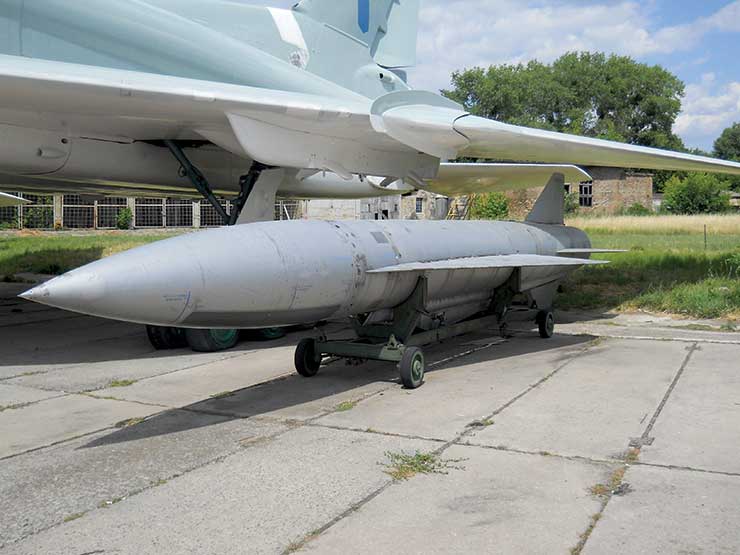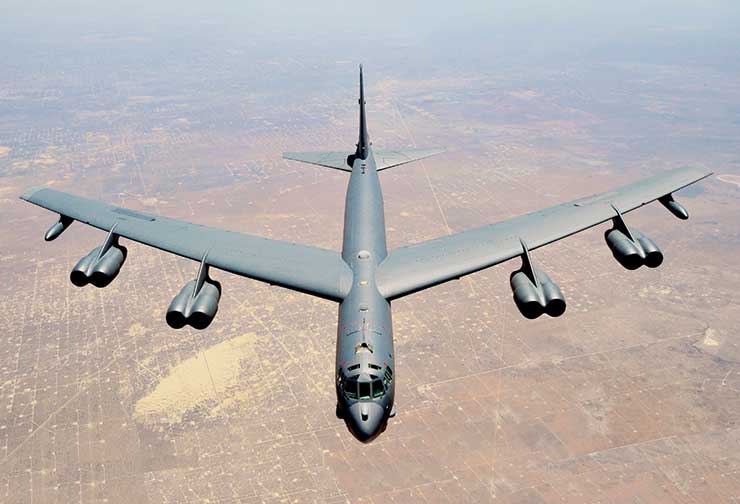The fastest way to sink an enemy warship is by attacking it from the air. Modern combat aircraft can travel hundreds of kilometres an hour, patrol far from their bases, and use standoff weapons to destroy targets from a safe distance. This is something that a surface combat ship simply cannot do. Long-range naval aviation is a force multiplier component of all the major global powers. The Russians were the first to see the value of having dedicated land-based bombers to attack US Navy carrier battle groups. Their Tupolev Tu-22M ‘Backfire’ bomber was developed to hunt and destroy enemy surface ships in the vast expanse of the Pacific Ocean.
The United States – despite having a forward deployed navy with as many as 10 aircraft carriers – has modified its B-1B and B-52 air force bombers for maritime missions. China’s People’s Liberation Army Air Force (PLA Air Force) has a dedicated fleet of Xian H-6D strategic bombers armed with anti-ship cruise missiles.
Lt-General David Deptula of the US Air Force writes in Air Force Magazine: “In a modern threat environment, especially in the Asia-Pacific region, the advantages of using bombers in a maritime strike role is becoming more relevant to future military strategies, plans and budget priorities.” Pairing long-range anti-ship missile (LRASM) with modern sensors, bomber aircraft can now conduct all-weather precision engagements against mobile maritime targets with less risk than naval vessels, and do so in hours, rather than days or weeks, he adds.
Maritime strike aircraft have three primary tasks:
- Anti-access – to destroy carrier battle groups or large flotillas out in the open sea; that is, before they come close to
your shores. - Their second – and equally important – role is to kick down the door of coastal air-defence systems, thereby making it safer for your navy to approach the enemy’s coast.
- And finally, maritime bombers can devastate the enemy’s mainland by launching cruise missiles from safe standoff distances.
China in the Indian Ocean
For India, the time has finally arrived to go in for a dedicated strike bomber because its prime adversary now has – at least on paper – a powerful blue water fleet. China’s PLA Navy is no longer a littoral force. In 2020, it became the largest navy in the world, with an overall battle force of approximately 350 ships and submarines, including over 130 major surface combatants. In comparison, the Indian Navy has 150 ships and submarines.
In a report submitted to the US Congress, the US Defence Department noted the majority of the PLA Navy fleet is made up of “modern multi-role platforms” that host anti-ship, anti-air and anti-submarine weapons and sensors. Further, as part of modernisation efforts, the Chinese have embarked on a shipbuilding programme that includes submarines, surface combatants, amphibious warfare ships, aircraft carriers, and auxiliary ships as well as indigenous weapons, sensors and command and control systems.
Unlike some of the wildly exaggerated reports that come spinning out of the Pentagon, this report was spot on. On June 17, 2022, China launched its third and most advanced aircraft carrier from Shanghai’s Jiangnan Shipyard. Named “Fujian”, the warship is China’s first domestically designed and built catapult aircraft carrier, and is equipped with new combat systems, including the electromagnetic catapult-assisted launch system, which is a major upgrade from the less advanced ski jump-style system used by India.
What’s more, the US Defence Department says the PLA Navy is developing the capabilities and operational concepts to conduct offensive operations within both the Pacific and Indian Oceans. Chinese and outside naval experts speculate that the PLA Navy may have an Indian Ocean fleet in the near future. Supporting this possibility, multiple Chinese sources have started to articulate an emerging Indian Ocean strategy for the PLA Navy.

Attack is the best defence
There are several compelling reasons for the Indian Navy to have its own dedicated carrier-killer and coastal bomber.
- By definition, a strategic bomber should have a minimum range of 8,000 km without refuelling and the capacity to carry a payload of more than 10 tons of air-to-ground ammunition, including several long-range cruise missiles. This means bombers have the range to attack enemy naval surface groups before they came within range of the Indian Navy ships. They can descend to low altitude, approach from different directions and launch salvos of anti-ship missiles such as the Brahmos to saturate enemy defences. What’s more, bombers can replenish their weapons (LRASMs) in hours versus the days or weeks ships require.
- If the Indian Navy detects a large enemy fleet that needs to be neutralised, it cannot expect to call in strikes by the IAF at a moment’s notice. The chain of command makes this cumbersome if not impossible. (This is the reason why the Indian Army is raising its own fleet of assault helicopters instead of always being at the IAF’s mercy.)
- The Air Force isn’t waiting to respond to a call from the Navy. Its fighters could already be deployed – or committed for deployment – in other distant theatres.
- Air Force jets lack the range required to go looking for warships in the vast expanse of the ocean. Carrier-borne fighters – whose primary role is to defend the carrier – have even shorter ranges. For instance, the Indian Navy’s MiG-29K – for safety reasons – rarely takes off with a full tank of gas, which severely limits its combat radius to well below its official 850 km range.
- Radars and avionics on Air Force jets are not always effective over water, and are in most cases useless. Without specialised equipment, an aircraft cannot tell whether a large contact held by its onboard radar is an aircraft carrier or other ship configured to simulate a carrier, a decoy, or a large and perhaps neutral merchant vessel.
- Air force pilots do not generally train for maritime missions. You want crews who do this for a living daily and have the experience to detect enemy ships on the turbulent ocean.

Countering the Chinese threat
China’s fleet includes three aircraft carriers, 32 destroyers, 49 frigates, 37 corvettes, 21 medium landing ships, 37 amphibious transport docks, 86 coastal patrol missile boats, a cruiser, 46 diesel attack submarines, 6 nuclear attack submarines and 4 ballistic missile submarines. On top of having the largest naval fleet in the world, the combined aviation presence of the PLA Air Force and PLA Navy aviation constitutes the third-largest aviation force in the world and the largest in the region. (The firepower of the US Navy is several orders of magnitude greater than the PLA Navy’s, and will be for several decades.) With such numbers at their disposal, the Chinese would be able to permanently deploy an aircraft carrier in the Indian Ocean in the coming years.
Instead of placing its naval assets within harm’s way, the Indian Navy can threaten Chinese carrier battle groups by deploying maritime bombers. Dedicated squadrons can be stationed on secure airbases on the mainland or even the Andaman & Nicobar Islands from where these bombers can be vectored towards large naval targets. In a shooting war, these bombers can fire cruise missiles against a Chinese carrier from beyond the range of the carrier’s own fighters; the pilots can then return to base and watch the carnage on CNN. The bombers can also be used to launch cruise missiles against cities on China’s eastern seaboard.
If India acquires such a capability, it will be able to strike China from two sides – across the Himalayas as well as the east. This will complicate war planning for the Chinese political leadership, which is already on edge because of the Pacific Pivot – the massive redirection of US economic and military focus from the Atlantic to the Pacific Ocean.

The Navy’s options
Maritime bombers aren’t available off the shelf so India’s options are limited. It could buy or lease the Tu-22M from Russia. In fact, the Backfire was first offered to the Indian Air Force in 1971 – a few months before the India-Pakistan War – when Russia offered it as a strategic bomber. However, Air Chief Marshal P.C. Lal rejected the offer.
According to defence analyst Bharat Karnad, the “reasons trotted out verged on the farcical”. “As Wing Commander (later Air Marshal) C.V. Gole, a member of the Air Marshal Shivdev Singh Mission to Moscow and test pilot, who flew the Tu-22M informed me, he was appalled by the fact that he had to be winched up into the cockpit, and that the plane would have to take off from as far east as Bareilly to reach cruising altitude over Pakistan!”
India could have bought these aircraft again – and at a huge bargain – in 1991 when the Soviet Union dissolved and Moscow was wondering what to do with 300 surplus Backfires. Although the Chinese have tried hard to buy the bomber or even its design blueprints – which is an indicator of the Backfire’s continued utility – India has refused to accept what was offered to it on a platter.
MARITIME BOMBER DEPLOYMENTS
RUSSIA
The Russian Backfire was the world’s first maritime strike bomber. With its combat range of 2400 km and a blistering speed of over 2300 kph (faster than most jet fighters), the Backfire is ideal for targeting aircraft carriers and large ships.
The Backfire’s primary weapon is the supersonic Raduga Kh-22 cruise missile. Russian tests reveal that when a shaped charge warhead weighing 1000 kg was used in the Kh-22 missile, the resulting hole measured 16 ft in diameter and 40 ft deep. Not even the largest carriers can survive such an impact, and at the very least will be out of commission for months.
Bill Sweetman and Bill Gunston write in ‘Soviet Air Power’ that the missile is so accurate it could be “programmed to enter the correct Pentagon window”. In fact, during the 1980s, Russian Naval Aviation was so sure about the accuracy of these missiles that the Backfire carried only one Kh-22, armed with a nuclear warhead.
Today’s Backfires are also equipped with the more advanced Kh-15. This missile climbs to an astounding 130,000 ft and then dives in on the target, accelerating to Mach 5, which makes it the world’s fastest aircraft-launched missile.
According to Sweetman, the Backfires were best at “scaring the bejesus out of carrier groups”.

UNITED STATES
Seeing the utility of Russian maritime strike bombers, the US is transforming its B-1B and B-52 long range bombers as ship killers. The B1B is currently test-firing the Long Range Anti-Ship Missile (LRASM), which can avoid obstacles such as islands and commercial shipping, receive further targeting data via satellite, and adjust its flight path to avoid enemy air defences before descending on a fleet of enemy ships. What makes the LRASM/B-1B combination stand out is the sheer amount of firepower the heavy bomber can deliver. Just three bombers could launch 72 missiles at a target.
CHINA
China’s Xian H-6D is a copy of the 1950s era Russian Tu-16 Badger bomber but with modern Russian turbofan engines which reportedly give it a combat radius of 3,500 kilometres. Introduced in the early 1980s, it is armed with two air-launched C-601 missiles, one mounted under each wing. An upgraded version, capable of carrying four anti-ship missiles, is currently under development.
These bombers are specifically targeted at US Pacific Fleet aircraft carriers. Although these slow bombers are likely to get shot down by American stealth aircraft in any engagement between the two countries, a few Xians could potentially get through the air defences of carrier battle groups and do serious damage.
Although still potent, the Backfire is essentially 1960s technology, and the aircraft may require considerable maintenance to keep it flying. Plus, with the Russians not exactly known for their after-sales service, the Indian Navy may not be keen to acquire the ageing warhorse.
Another option is to modify the Sukhoi Su-30MKI, which is currently manufactured at HAL. This will not only require major retooling to install specialised maritime radars and other sensors, but also involve extending the range of the aircraft. With drop tanks or aerial refuelling, the aircraft’s considerable range can be extended further. However, the aircraft would be limited to firing just a single cruise missile such as the BrahMos. If the missile misses, the mission would be a failure.
Since the cost of transforming the Flanker into a maritime bomber is likely to be in the region of several billion dollars, and it still wouldn’t give India a true strategic bomber, the next best option is to design one from scratch.
Made-in-India bomber
Developing a bomber isn’t an easy task with the current level of aeronautical technology available in India. Even the Chinese are finding it hard to develop a more advanced version of their existing Xian aircraft. The editor of the Chinese language Defence Daily is sceptical about China’s abilities to produce a modern long-range strike bomber in the short term, considering that it would require “a state-of-the-art structure and aerodynamic configuration as well as a high-performance turbofan engine”.

However, the Chinese did manage to develop the Xian H-6D by reverse engineering during 1950s era Russian aircraft and cruise missiles. Plus, if they can build an 80,000 ton supercarrier in just seven years, they will eventually produce a strategic bomber that comes close to the capabilities of the US B-52 or the Russian Tupolev. The important thing is they are on the job whereas an Indian strategic bomber is not even in the picture.
If a dedicated joint sector company – on the lines of the highly successful BrahMos Aerospace – is set up today, then maybe India will have a bomber in 10 years. That is roughly the time frame it took the Defence Research & Development Organisation (DRDO) to bring the BrahMos cruise missile from concept to production. Back then luckily for India, President A.P.J. Abdul Kalam took a keen interest in the programme and used his clout to navigate the BrahMos through the Prime Minister’s Office. Kalam also made sure bureaucrats – and corrupt generals – weren’t able to sabotage the BrahMos. Today, there is a pro-military government which is pushing defence production as a priority, so an ‘Indigenous Strategic Bomber’ project could take off quickly without red tape dragging it down.
Maritime bombers are a more cost-effective gamechanger than matching an adversary with deep pockets. According to Lt-General Deptula, they can carry large payloads and travel long distances at a speed of 30 to 40 times faster than ships, while requiring a fraction of the resources and manpower to achieve commensurate combat effects.
The wonderful thing about strategic bombers is they often outlast the people who build them. This makes them highly cost-effective fighting platforms in the long run. The American B-52, which first flew in 1952, is an extremely robust flying machine that will in all probability be flying into the second half of this century, becoming the first centurion aircraft in history. The Russian Backfire could also hit the 100 year mark. China has built only 16 Xian bombers, suggesting these will be long-term assets. Similarly, if India develops a long-range bomber it will have a platform that will last decades, which means very little additional development costs.
–The writer is a globally cited defence analyst. His work has been published by leading think tanks, and quoted extensively in books on diplomacy, counter terrorism, warfare and economic development. The views expressed are personal and do not necessarily reflect the views of Raksha Anirveda
–The writer is a globally cited defence analyst based in New Zealand. The views expressed are of the writer and do not necessarily reflect the views of Raksha Anirveda






